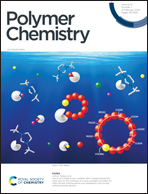Understanding differences in rate versus product determining steps to enhance sequence control in epoxide/cyclic anhydride copolymers†
Abstract
Aliphatic polyesters are an important class of polymers that are promising alternatives to current mass produced plastics. Specifically, copolymers of aliphatic polyesters have promising physical and degradable properties. Herein, the one-pot synthesis of block and random polyesters via the ring opening copolymerization of epoxides and cyclic anhydrides is investigated using simple yttrium salt catalysts. When the polymerization of multiple epoxides is performed in the presence of a single anhydride, individual turn-over frequency values (which correlate to reactivity ratios) can accurately predict the final polymer morphology that is achieved a priori using the Mayo–Lewis equation. However, when mixtures of anhydrides are polymerized in the presence of one epoxide, non-terminal compositional fit data has to be extrapolated for every monomer pair to determine reactivity ratios. The impact of rate versus product determining steps on monomer sequence and implications for future studies are discussed.



 Please wait while we load your content...
Please wait while we load your content...